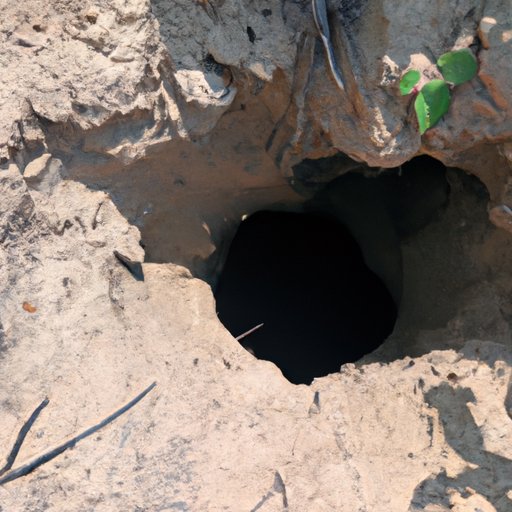Introduction
Do you know what a sinkhole is? If not, you have come to the right place. This article will introduce you to the mysterious world of sinkholes, explain what they are, and how they form. This article is intended for anyone interested in geology, natural disasters, or simply curious about the world around them.
Understanding Sinkholes: What They Are and How They Form
A sinkhole is a geological phenomenon that forms when the surface layer of the ground collapses, revealing a cavity beneath. Sinkholes can form naturally due to geology, weather, or other conditions, or they can be caused by human activity. Three types of sinkholes are common: dissolution, cover-subsidence, and cover-collapse sinkholes.
Dissolution sinkholes form in areas underlain by soluble rock, such as limestone and gypsum. Over time, groundwater dissolves these rocks, creating cavities in the earth.
Cover-subsidence sinkholes form when underground material, such as sand or clay, is washed away by water, causing the overlying soil to sink down.
Cover-collapse sinkholes occur when the ground, unable to support its own weight, suddenly collapses due to the loss of underlying support.
Common causes of sinkholes include heavy rains, changes in groundwater levels, earthquakes, and the draining of underground water reserves.
The Science Behind Sinkholes: A Comprehensive Guide
Several factors contribute to sinkhole formation. Geology plays a significant role, specifically the type of rock beneath the soil surface. Water is another critical factor in sinkhole formation. When the soil is saturated or waterlogged, it becomes heavy and collapses. Droughts can also cause cracks and fissures in the earth’s surface, which may lead to sinkhole formation. Human activity can also play a role in sinkhole formation, including mining, drilling, leaking pipes, and construction activities.
To identify and monitor sinkholes, geologists and other experts use techniques such as remote sensing, geophysical surveys, drilling, and mapping. These tools allow them to better understand where sinkholes may form and take necessary precautions to avoid and mitigate the impact of sinkholes.
When the Ground Gives Way: Exploring the Dangers of Sinkholes
Sinkholes can cause significant damage to property and infrastructure, and they can even be fatal. Large and sudden sinkholes can swallow up entire buildings, cars, and other structures, leading to loss of life. Sinkholes can also cause significant financial damage, as the repair of these collapses can be expensive and sometimes impossible. In addition, sinkholes can lead to water loss and contaminated groundwater, further affecting the surrounding environment.
Sinkholes Around the World: Famous Examples and Their Impact
Sinkholes have occurred all over the world, some more famous than others. Some of the most famous sinkholes in history include the 2010 Guatemala City sinkhole, which measured 66 feet wide and 100 feet deep, the 1981 Winter Park, Florida sinkhole, which swallowed a house, and the 2013 Corvette Museum sinkhole in Kentucky. These sinkholes have caused significant damage and even loss of life in some cases. In response, authorities and communities have implemented different measures to remediate the impact of sinkholes, including filling and stabilizing the ground around the sinkhole and adjusting building codes to account for potential sinkhole risk.
Preparing for the Worst: Tips for Dealing with Sinkholes on Your Property
If you live in an area prone to sinkholes, it is essential to take necessary precautions to protect your property and assets. Some of the signs that a sinkhole is forming include cracks and depressions in the land, changes in water levels, vegetation that is dying unexpectedly, and structural damage to buildings. To prevent the formation of sinkholes, avoid over-pumping of groundwater reserves, properly seal wells, and maint clear drains and drainage ditches. If you discover a sinkhole on your property, stay away and call the appropriate authorities immediately. Remediation techniques for smaller sinkholes include filling with sand, gravel, and other materials to prevent further collapse. For larger sinkholes, more extensive repairs are necessary.
Conclusion
Sinkholes are an unpredictable natural phenomenon that have both fascinated and terrified people for centuries. Understanding the different types of sinkholes and how they form can help us better predict and respond to sinkhole events. As individuals, we can take practical steps to protect ourselves and our communities from the dangers of sinkholes. By properly identifying the signs of a forming sinkhole and taking necessary precautions, we can help prevent damage and loss of life from these unexpected geological events.
